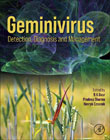
Geminivirus: Detection, Diagnosis and Management
Gaur, R.K.
Sharma, Pradeep
Czosnek, Henryk
Geminivirus: Detection, Diagnosis and Management provides comprehensive coverage on the virus' detection, diagnosis and management. Key themes include host range determinant and factors involved in pathogenesis, virus-vector interactions during acquisition, retention and transmission, and evaluating management strategies for control. This book is an essential read for students and researchers interested in plant virology, particularly begomoviruses, geminiviruses and vector transmission. Understanding plant virus evolution is crucial for modeling the within-host and between host dynamics and genetics of virus populations such as population bottlenecks during cell-to-cell movement, systemic colonization, or between-host transmission by different procedures. Provides a comprehensive characterization of Geminiviruses that infect agricultural crops, along with their wild relatives and weeds Covers recombination and reassortment mechanisms that influence viral genetic diversity, virulence and vector transmission Presents discussions on origin, evolution and bottlenecks of Geminiviruses INDICE: Section I: Detection and Diagnosis 1. Current challenges and future perspectives on detection of geminiviruses 2. Geminiviruses: Identification, Characterization and Sensitive Detection Techniques, In Agricultural-Crop Hosts, Wild Relatives and Weeds 3. Identification of geminiviruses from woody plants by RNA and small RNA sequencing 4. Recent developments in the diagnosis of Geminiviruses 5. Fluorescent Microscopic Technique to detect geminiviruses in plant tissue 6. Impact of sequencing trends and bioinformatics in the development of diagnostics and virus discovery of Geminiviruses Section II: Emergence and Diversity 7. Geminivirus disease complexes: an emerging threat 8. Origin, evolution and bottlenecks of geminiviruses 9. Capulavirus, a clandestine geminivirus group 10. Host Adaptation and evolution of distinct begomoviruses: Mungbean yellow mosaic/Mungbean yellow mosaic India virus and Tomato leaf curl New Delhi virus and its emergence as challenging pathogens 11. Begomoviruses in crops with economic interest for North and Central America 12. Pathogenic Determinant of Tomato Leaf Curl Guangdong Virus 13. Diversity of Begomoviruses infecting crops and weeds in the Caribbean and Latin America 14. Diversity of Geminiviruses occurring on Jatropha, a Bio-diesel crop 15. Geminiviruses in West and Central Africa 16. Emergence and Spread of Begomovirus Complex Infecting Various Crops, and Disease Management in the Philippines 17. Geminiviruses occurrences in the Middle East and their impact on agriculture in Iraq 18. Manipulation of plant host by Geminivirus Section III: Vector and Transmission 19. Transovarial transmission and replication of begomovirus in their whitefly vector: myth or reality 20. The other face of pollinating insects and their relationship to geminivirus transmission 21. Begomovirus-whitefly vector diversity, demographics, and interactions among crop and wild host species in the American Tropics 22. Behavioral manipulation for managing Bemisia tabaci as a geminivirus vector 23. Changes in vector genotype composition correlates with change in tomato yellow leaf curl disease viral specie in hot-spot location in Southern Italy Section IV: Virus-Host Interaction 24. C4/AC4 Protein Multifunctional Role in Geminivirus Infection: Where size Doesn't Matter 25. Geminivirus DNA replication in plants 26. Effect of Begomoviral Movement Protein in Human cell 27. Begomovirus-host interactions in movement 28. ßC1 proteins of geminivirus and interaction with MPK of plant host 29. Geminivirus promoters: A breakthrough in transgenic research 30. Insights into the host range determinant and factors involved in geminivirus pathogenicity 31. The Begomovirus-Host Interplay in Viral Replication and Movement 32. Post-translational modification of proteins in plant-geminivirus interactions 33. Transcriptomics of geminivirus-vector transmission and molecular arms race between geminiviruses and plants during infection cycle Section V: Disease Management 34. Resistance to geminivirus infections: Natural and Induced by Controlled elicitation 35. Invasive TYLCV recombinants challenge virus diagnosis and disease management 36. Natural and engineered host resistance for management of geminiviruses 37. Overview of host and viral factors involved in disease development and resistance 38. CRISPR-Cas9 interference and Geminivirus 39. Mechanisms, strategies, and applications of peptide aptamers in geminivirus resistance 40. Integrated management strategies to control Geminivirus 41. Molecular insight into cotton leaf curl geminivirus disease resistance in cultivated cotton 42. Advantages and disadvantages of current strategies of geminivirus management; perspectives
- ISBN: 978-0-323-90587-9
- Editorial: Academic Press
- Encuadernacion: Rústica
- Páginas: 600
- Fecha Publicación: 01/06/2022
- Nº Volúmenes: 1
- Idioma: Inglés
